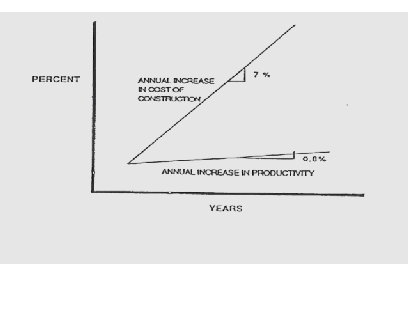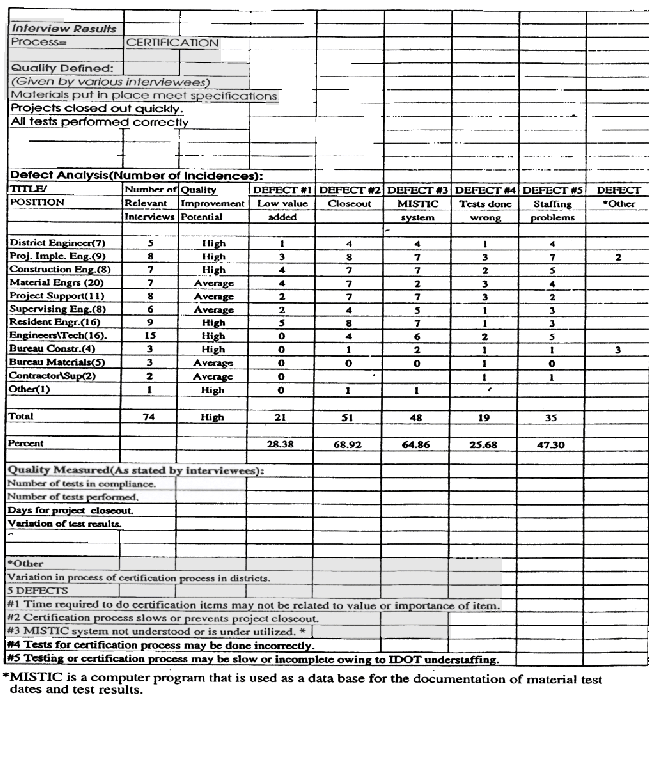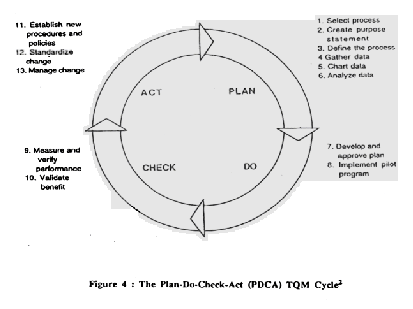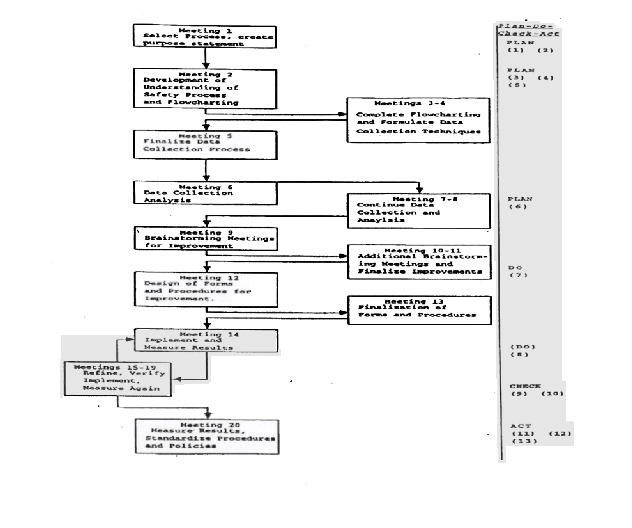|
(pressing HOME will start a new search)
|
|
TQM Prototype Implementation Model: Results of a Research Experience
Farzad
Shahbodaghlou and James J. Adrian
Bradley
University
Peoria,
Illinois
|
Following a Request for Proposal (RFP) by the Illinois Transportation Research Center, a research team from Bradley University submitted a proposal for application of TQM to construction and material testing functions of Illinois Department of Transportation (IDOT). The grant was awarded and the result of its ensuing research is presented herein. This paper discusses TQM and its application to the construction industry as well as the proposed prototype implementation model for application of TQM to the certification process by IDOT. Keywords: TQM, Total Quality Management, Construction Management |
Introduction
The
Illinois Department of Transportation (IDOT) has historically employed an
intensive and comprehensive construction and material inspection testing
approach in monitoring the construction of its roadway projects. In recent
years, however, the make up of the types of construction projects has changed
considerably. Up through the 1970's many of IDOT's projects consisted of large
new-construction type projects as part of the interstate system in Illinois.
In the 1980's and 90's, however, rehabilitation of existing facilities has
made up the majority of its roadway projects. These rehabilitation projects,
which are smaller in scope compared to new-construction jobs, have resulted in
an increase in the total number of projects under construction at any one
time.
In
addition, over the last fifteen years, the Division of Highways technical work
force involved with materials and construction inspection at the District and
Central Office level has steadily declined. This trend was accelerated
recently with the implementation of an early retirement program. The
combination of the loss of experienced employees and reduced size of its work
force, in addition to the increase in number of projects, has compelled the
Division of Highways to seek new ways to insure that the quality of
construction and materials inspection/testing remain at historically high
levels. IDOT has previously employed several efforts such as materials
certification, quality control/ quality assurance concepts, and judicious use
of consultants to address this problem. However, recently, the Division of
Highways judged it prudent to investigate application of new concepts, such as
Total Quality Management (TQM) , to address the above issues.
TQM
is a management approach that attempts to focus more on problem solving as
opposed to the traditional approach of monitoring and inspecting. This concept
focuses on improving a process through elimination or reduction of defects and
low value tasks. The goal is to strive for continuous improvement in a process
through analysis and measurement, implementation of new ideas and procedures
for improvement, and the repeat of the analysis and measurement steps. The
cycle of improvement is on-going.
In
an effort to improve the quality of a process, the needs of external and
internal customers of the process are identified. Improvement in the process
is also attained by seeking the input of employees. The objective is to change
the mindset of the employee from one of only monitoring the process, to one of
also continually looking for improvements.
With
the objective of investigating the benefit of implementing TQM concepts to
address its concerns as noted above, the Division of Highways, through the
Illinois Transportation Research Center, initiated a Request for Proposal to
investigate the possible application of TQM to its construction and material
testing functions. The Department of Civil Engineering and Construction at
Bradley University submitted a proposal for this research and was awarded the
grant.
Given
the above objective, the research team reviewed the construction contract
administration as well as the Construction and Materials functions within the
Division of Highways. This was done with the intent of recommending Total
Quality Management (TQM) related concepts and procedures to maintain and
improve the quality of the final constructed project. The study did not
include the contract procurement function. However, all other processes
performed within construction, materials, and contract support were studied.
The final report included the following chapters: Literature Review and TQM
Overview, Interview Process and Results, Appraisal of Process Improvement
Potential Using TQM, and Prototype Model for Implementation of TQM. All
chapters except for "Literature Review and TQM Overview" are
discussed in this paper. For the sake of brevity, it is assumed that the
reader is familiar with the TQM process. However, several sources on this
topic are available from the authors upon request.
TQM
and Its Application to the Construction Process
In
recent years the construction industry has turned its attention to the
implementation of TQM. Project owners to include public agencies, design
firms, and contractors have started to embrace the process. In regard to the
construction, this process is highly competitive and is hurt by adverse
relationships, absenteeism, low morale, and high turnover.' TQM is a method
that can be used by the industry to improve the construction process.
Why
TQM Applies to the Construction Process The construction industry and process
is often characterized as being burdened with problems, cost and time
overruns, disputes, and lawsuits. The construction process is very complex;
requiring the use of many labor skills, different materials, and complex
technical and management systems. In addition, uncertain and changing weather
conditions and external factors such as regulations make it very difficult to
control project results. Frequently one reads in the newspaper about projects
that take too long to construct, go over budget, or include disputes that may
need to be resolved by legal means or arbitration.
The
industry can also be viewed as one where the project owner has seen cost go up
while productivity, or the work the project owner receives per dollar of
expenditure, has remained relatively flat. This is illustrated in Figure 1. `
It can be argued that the project owner is paying more for the same product in
that there is considerable cost inflation in the industry.
|
|
|
Figure
1. Increasing Cost Without Increasing Productivity |
Critics
argue that the problems of the construction process and industry relate
primarily to the failure of the industry to incorporate the following three
major focuses of TQM:
1.
The construction industry has not focused on the detailed needs of the
customer (for example, the end user of the project).
2.
The construction industry has not capitalized on the knowledge of all
project entities. In addition, the various technical skills and management
know how of the diverse parties involved in the construction process have not
been integrated into a common approach to problem solving.
3.
The construction industry has not implemented many industrial
engineering and measurement techniques to include statistical sampling. As
such, it can be argued that the industry, lacking this measurement, does not
have an effective means of improvement. Instead of focusing on processes and
causes of problems, the industry has focused on monitoring and inspection of
results. As an example, the construction industry does not monitor the amount
of non-productive time at a project, the number of incidences of redo work or
punch list work, the number of days it takes to do various tasks, etc. This
lack of measurement leads to acceptance of the "defect." For
example, it has become commonplace to accept non-productive time or the need
to do redo work. Using a TQM approach, the cause of these "defects"
are quantified and analyzed. The focus is on the elimination of the cause of a
defect.
Constraints
to the Use of TQM in the Construction Process Some critics and skeptics argue
that the TQM process does not apply to the construction process because of
unique construction characteristics. In particular it might be argued that the
following unique characteristics of the construction process may make TQM
difficult to implement:
1.
The construction process is relatively short in duration. A
construction project may take less than a year to construct. Given this short
term characteristic, it may be difficult to realize benefits that may be more
long term in nature.
2.
A high percentage of the labor at a construction project only work for
the construction firm for a short time period; they can be viewed as a
transient labor force. As such it may be somewhat difficult to
"empower" the workers and get them committed to a team process.
3.
Construction projects are unique, each project being somewhat
different. That may reduce the ability to implement continuous improvement.
4.
Project owners may take a short-term view in that they have
historically attempted to control their projects by including penalties for
non-performance and have focused on monitoring results through inspection.
While
the above constraints relate to the application of TQM to the construction
process, the arguments given earlier in regard to why the construction
industry needs TQM (focus on customer, get workers involved, and focus on the
measurement of causes of problems) more than overshadow these constraints.
What is needed is some modifications of the TQM process to recognize the
unique characteristics of the construction process.
Interview
process and Results
As
part
of the work program to
learn IDOT processes and to determine applications of TQM to these processes,
a series of interviews were conducted. These interviews were conducted at each
of the nine IDOT district offices, at the bureau offices of construction and
materials, and at outside entities, such as construction contractors. In
anticipation of these interviews
the research team prepared interview questionnaires. The interviews were
conducted between December, 1993 and May, 1994. A cross section of job
positions within IDOT were interviewed with the goal being to obtain objective
input from personnel with varying educational and experience backgrounds.
The
interviewees focused on the following:
Identification
of processes
Definition
of quality for the identified processes
Identification
of how quality is or could be measured
Defects
in the processes
Potential
for improvement of processes using TQM
The
summary of the interviews, grouped by the identification of twelve processes,
were included in the report. The conclusions from these interviews were the
following:
1.
Twelve processes were defined.
2.
Defects or improvement potential exist for all twelve of the processes.
3.
While quality can directly or indirectly be defined for all twelve
processes, IDOT needs better methods of measuring this quality such that it
can be improved.
4.
To a certain extent, each of the processes identified can be improved
through the use of TQM.
Appraisal
of process Improvement Potential Using the TQM
One
of the assignments of the research team was to select an IDOT process for the
development of a prototype model for possible implementation of TQM. Near the
conclusion of the interviews, a meeting was held with the project's technical
review panel to select the process for the prototype model.
To
aid the committee select a process, the results of the interviews were
summarized in a format that set out defects and the potential for improvement
using TQM. The following twelve processes were reviewed:
1.
Certification of Materials
2.
Documentation of Materials and Methods
3.
Decision Making at Projects
4.
Payment of Contractors
5.
EEO Contract Administration
6.
General and Subcontractor Administration
7.
Change Order Administration
8.
Claim-Dispute Resolution
9.
Traffic Control and Safety
10.
Public Relations
11.
Personnel Management
12.
Quality of Projects
Based
on the potential for improvement, the potential benefits from applying TQM,
and the cross sectional nature of the process, the committee selected the
Certification of Materials as the process for the prototype model. This
selection was compatible with the Bradley University research team's
recommendations as determined from rating each of the processes. Federal and
state agencies require a data base to be maintained that lists all tests taken
and their results. They also require that any materials used on the state
highways (for example gravel, tape, etc.) be approved when purchased from a
vendor. The process involved in keeping track of all these is called the
Certification of Materials process. Figure 2 shows the interview results
summary for this process.
|
|
|
Figure
2. Interview Results Summary for the Certification Process |
Prototype
Model for Implementation of TQM
One
of the work program tasks was to set out a prototype model for TQM and a
schedule for implementation. MOT expressed a preference for an implementation
schedule that would enable them to determine benefits in a short time period; in
approximately six months.
The
research team included steps for implementing TQM for the Certification of
Materials process. This was done by listing a step by step process, starting
with the Executive Briefing Seminar and concluding with the review of prototype
model and TQM implementation. These steps are presented in Figure 3 in the form
of a flow chart.
|
|
|
Figure
3. Implementation Schedule for TQM Model |
The
core of the TQM process is the utilization of teams, referred to in the report
as Quality Improvement Teams (QIT's). Included in the steps set out in the
report is a listing of the training courses to be provided to QIT leaders and
the process of selecting team leaders and members of the QIT's. It is
anticipated that initially two QIT's are formed. Both QIT's will focus on the
Certification of Materials process. Normally in a full implementation of TQM,
more QIT's and employees would be involved in the TQM process. However, owing to
the fact that a limited prototype study is being proposed, the TQM process is
modified to limit itself initially to the two QIT's.
The
most detailed step in the seven steps set out for TQM implementation is step
number six, the implementation of the prototype model itself. This entails a
process that consists of twenty meetings of the QIT's. The agenda for each of
these meetings was included in the final report. In addition, where appropriate,
forms and procedures were designed for use by the QIT's.
The
research team, in its prototype TQM implementation program, set out several
steps based on the above concepts as shown in Figure 3. A summary of the purpose
and a list of necessary attachments (only a few of the attachments are included
in this paper for lack of space) for each step is provided below:
Step 1: Executive Briefing Seminar
Purpose:
1.
To present the program to the top management.
2.
To seek the commitment necessary by the corporation.
Attachments:
(Not shown in this paper due to space limitation, but available from the
authors)
1.
Outline for executive briefing seminar.
2.
Statement of need for support from top management for
implementing TQM prototype model.
It
is critical that top management support and commit to the implementation of the
prototype model if it is to be successful. A minimum of one year commitment is
needed to evaluate the benefit of the implementation. Three groups are
identified for the prototype implementation:
Management
Group (top management)
Facilitators
Quality
Improvement Teams TQM
The
Management Group is responsible for overlooking the project and for setting up
and monitoring policies and procedures of the QIT's and facilitators.
The
management Group will communicate monthly with the QIT's through the
facilitators. The communication must be a two way process. The management Group,
by example and by their actions, is to provide the following four critical
elements to the TQM prototype implementation:
Commitment
to the process.
Recognition
to those involved.
Drive
out fear such that all employees are willing to give new ideas and employees
will not be threatened for giving these new ideas.
Delegate
and drive decision making and problem solving to the lowest practical level.
Included
in the commitment attribute is the willingness to commit to educational efforts,
the budgeting of meeting time, and small expenses that may be required during
the implementation.
Step 2: Identify Team Leaders and Facilitators
Purpose:
1.
The TQM implementation will require the formation of several teams to
include the management Group, the Facilitator Group, and the Quality Improvement
Teams. While the "team concept" is critical to the TQM process, each
team will need a team leader or "coach". These leaders will provide
"coaching" for each team and also serve as the communication link
between each of the groups.
2.
It is important that the leaders or coaches be identified first and early
in the process. It is anticipated that these group leaders will attend a two to
three day training session on subjects outlined in step 3. After being trained,
it is anticipated that all or a select number of the leaders will provide the
same training to all other employees selected to participate in the process.
Attachments:
(Not shown in this paper due to space limitation, but available from the
authors)
1.
Overview of organizational team structure.
2.
Description of groups and criteria for selection of group
leaders.
Step 3: Train Team Leaders and Facilitators
Purpose:
1.
To provide the team leaders and facilitators with the training and skills
to implement TQM.
2
In addition to providing the team leaders and facilitators the necessary
training, the intent is to train these individuals such that they can offer the
same training material to their group members. Because some of this subsequent
training will be done in groups (more than one group attend at the same time and
location), not every leader will be expected to provide training. However, the
purpose of this initial training, is in part, to determine which individuals are
best at providing the QIT training.
Attachments:
(Not shown in this paper due to space limitation, but available from the
authors)
1.
Outlines for proposed training courses (4 hours each) asfollows:
Course
Number TQM-1
Introduction
to Total Quality Management (TQM)
Course
Number TQM-2
Measurement
Techniques
Course
Number TQM-3
Problem
Solving
Course
Number TQM-4
Effective
Communication
Course
Number TQM-5
Team
Building and Group Dynamics
Course
Number TQM-6
Improvement
of Certification Process
Steps 4: Quality Improvement Teams (QIT's) Formed
Purpose:
1.
The basic foundation for the TQM process is the improvement teams. TQM
advocates suggest team sizes of 3 to 12 individuals. The research team would
propose that each QIT consist of six individuals to include the team leader
(coach). In selecting the QTT team members, the following concerns should be
considered:
a.
The teams should consist of members from a cross
section
of job responsibilities, educational background,
and
skills.
b.
Team members should be willing to work with others.
c.
A team member should be willing to listen as well as instruct.
d.
A team member should have a basic knowledge of the process (no need for in depth
knowledge).
e.
Team members should be selected based on their ability to attend all or the
majority of the meetings for a twelve month period.
f.
Team members should reflect varying number of years of experience.
g.
Team members should be creative and open minded.
h.
Knowledge of other processes is valuable.
2.
The team members are to be selected with the input of
the top management.
It
is preferred that the makeup of each team be different in regard to the job
titles of team members. The diversity of the QTT's will aid in evaluating the
benefits obtained and also should in part reflect the unique nature of each
branch of the company.
Attachments:
(Not shown in this paper due to space limitation, but available from the
authors)
1.
Overview of organizational team structure.
2.
Criteria worksheet for selection of team members.
Step
5: Train Quality Improvement Teams (OTT's)
Purpose:
1.
To provide the QIT members with the training and
skills to implement TQM.
2.
This training is to be provided by select group leaders based on their
presentation skills exhibited in the group leader training sessions.
3.
It is anticipated that the three days of courses will be broken into
three one day sessions. Individual group members will be able to attend any one
day of the training at different times and locations. However, all training
should be completed prior to the collection of data for the prototype
implementation phase.
Step
6: Prototype Model Implementation (Certification Process)
Purpose:
1.
To implement TQM for the certification process using the QTT's that have been
organized and trained.
2.
To aid the QIT's implementing TQM for the prototype model by providing guidance
with meeting agenda and suggested forms and procedures. NOTE: The proposed
meetings and implementation are organized to be compatible with the Plan-Do
Check-Act (PDCA) TQM cycle. The outline of the twenty implementation meetings
are referenced to the PDCA chart shown in Figure 4. This outline is shown in
Figure 5.
|
|
|
Figure
4. The Plan-Do-Check-Act TQM Cycle |
|
|
|
Figure
5. QIT Meeting Process for Continuous Improvement |
Attachments:
1.
Overview of Plan-Do-Check-Act cycle and implementation meetings (20)
for prototype model. (see Figure 4)
2.
Agenda for each of the twenty implementation meetings. (Not shown in this
paper due to space limitation, but available from the authors)
Step 7: Review of Prototype Model and TOM Implementation
Purpose:
1.
After implementing the prototype model (step 6), it is anticipated that
the, top management will evaluate the benefit to cost/effort of the TQM
application.
2.
If difficulties were encountered during the prototype application, they
are to be analyzed with the intent of either correcting them or considering them
in the decision to proceed or not to proceed with TQM.
Attachments:
(Not shown in this paper due to space limitation, but available from the
authors)
1.
Worksheet for evaluation of benefits of TQM implementation.
These
seven steps, conducted over a six month period will provide MOT with a
collection of policies and procedures which are developed by the members of that
same organization based on its particular characteristics. These policies and
procedures will attempt to get at the cause of the bottlenecks and other
shortcomings in the certification process.
Concluding
Summary
This
implementation process, provides IDOT with a step by step procedure for the
development of its TQM program. While the research team has provided the
framework and guidance via this model, it is critical to note that these steps
are not the solution, rather, they are merely the means to developing solutions
through collective involvement of IDOT employees at all levels. The actual steps
to include data measurement, flowcharting, brainstorming for improvement, and
implementation of improved procedures and forms aimed at process improvement are
to be performed by IDOT under supervision of the research team in the next phase
of this project.
The
next step is IDOT implementation of this proposed program. The research team
will then review the results and report on its finding in a future paper.
Acknowledgment
The
research work presented in this paper was sponsored by a grant from the Illinois
Transportation Research Center (ITRC) and the Illinois Department of
Transportation. The authors are grateful to the sponsors of this project.
References
1.
Adrian, James J., Construction Productivity Improvement (Elsevier, New
York, New York, 1987) p. 5.
2.
The Associated General Contractors of America, Implementing TQM in a
Construction Company (Washington DC 1993) p. 1.
3.
Business Week, The Quality Imperative (New York, New York, January 15,
1992) p. 20.





